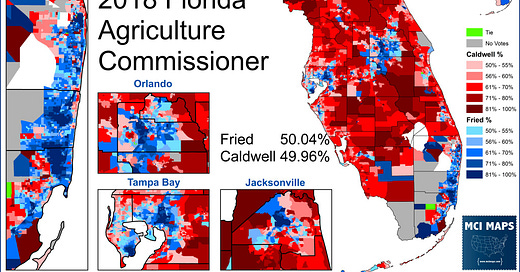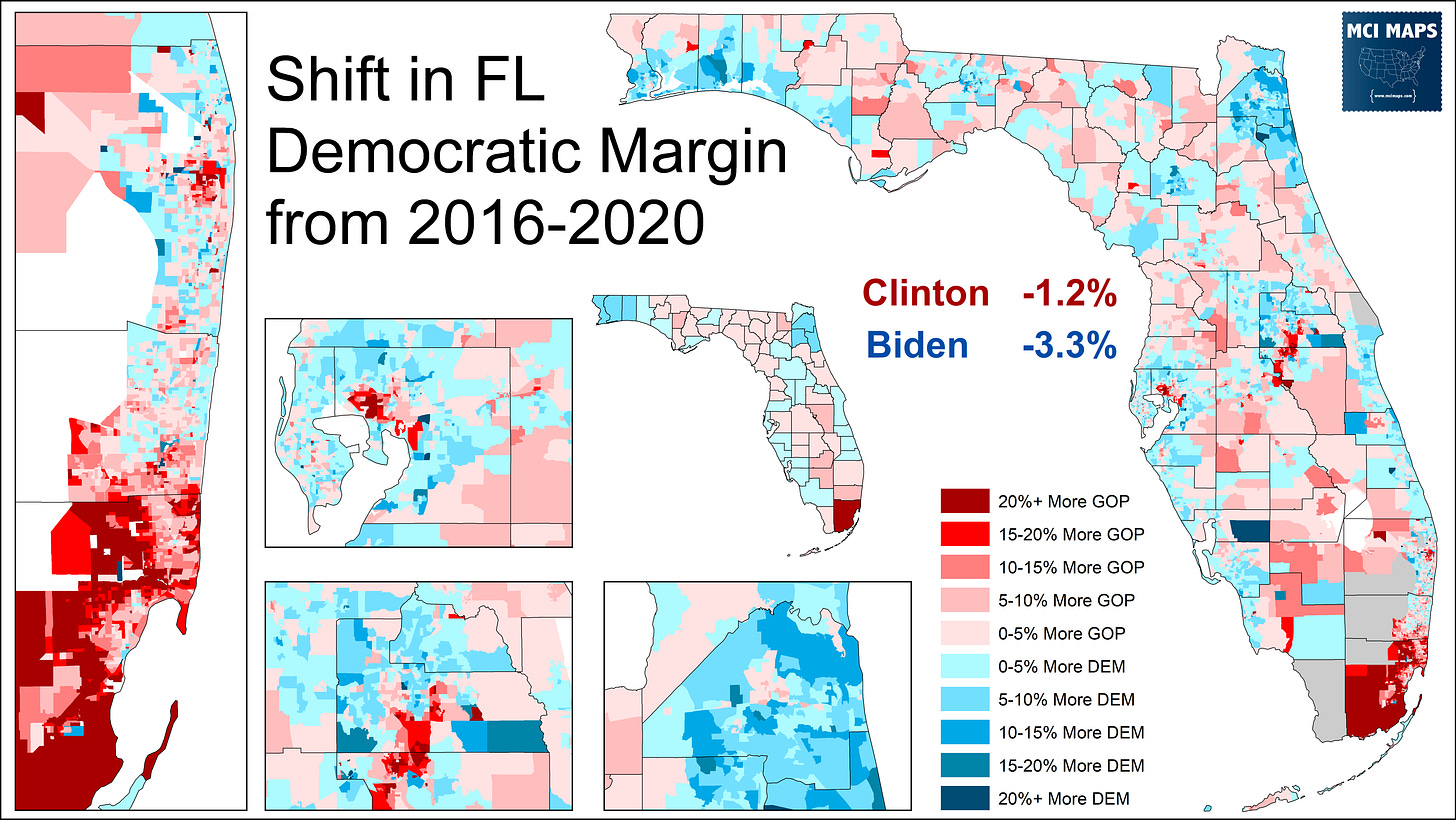Issue 1: The 2018 Election of Nikki Fried
Florida's Agriculture Commissioner is going to run for Governor. Lets look at how she won her office.
On June 1st, its expected that Florida’s Agriculture Commissioner, Nikki Fried, will announce a run for Governor. Fried is currently the only statewide Democrat in Florida; winning the same night that Bill Nelson and Andrew Gillum lost their races for Senate and Governor. Her run will set off a potentially explosive showdown with Governor Ron DeSantis. In light of this announcement, I want to take a look at Nikki Fried’s 2018 election and how she managed pull off her victory while the Democrats around her fell.
The 2018 Agriculture Commissioner Election
Nikki Fried was in the mix for a potential run for office for some time after the 2016 elections. As a prominent lawyer and lobbyist from Broward County, the biggest base of Democratic votes in the state, Fried had a strong profile to run off of. One of Fried’s most notable lobbying ties was to the medical marijuana industry; a popular industry with Democrats. Fried opted to run in Florida’s Agriculture Commissioner race; making marijuana a major issue in her campaign.
Medical marijuana was a big issue in Florida at this point. The practice had been legalized by Florida voters in 2016 by an overwhelming margin. That win had followed a 2014 measure that got 58% but fell short of the 60% threshold. Either way, Florida voters had twice signaled support for medical marijuana.
For most of the primary, Fried was most known for her support of medical marijuana, an issue that was still being debated as the legislature wrestled with how to implement the 2016 amendment.
Fried faced two opponents in her primary: Homestead Mayor Jeff Porter, and South Florida Audubon Society head David Walker. Fried maintained a significant fundraising lead through the primary and in the end secured a majority of the primary.
Meanwhile, the Republicans were holding a crowded primary of their own. State Representative Matt Caldwell emerged with a 35% plurality victory over State Senator Denise Grimsley and former State Rep Baxter Troutman. Caldwell is a steadfast conservative Republican.
The primaries set up a general election of Caldwell vs Fried. Both candidates would have to vie for attention in a cycle that would be dominated by Rick Scott vs Bill Nelson and Andrew Gillum vs Ron DeSantis. Democrats, however, had succeeded in fielding strong candidates for all five statewide races up that year.
US Senate: Bill Nelson
Governor: Andrew Gillum
Attorney General: Sean Shaw
Chief Financial Officer: Jeremy Ring
Agriculture Commissioner: Nikki Fried
In 2014, Democrats put little effort into winning anything outside of Governor. This time, Democrats had a full and diverse slate of candidates.
Weapons, weed and water
The Fried campaign kept their messaging - which was destined to be drowned out by the higher-profile Gubernatorial and Senatorial contests - narrow and consistent. They touted their message strategy as the three “W’s”: weapons, weed, and water.
Fried highlighted that the Agriculture and Consumer Services Department oversees concealed-weapons licenses. With this, she made gun control a central part of her campaign. Fried met with parents of the Parkland School Shooting victims and received support from national gun control groups.
On weed, Fried made her support and work with medical marijuana a central issue. She argued for increased access - putting her in conflict with the broad Republican position of limiting who get medical marijuana licenses. Fried saw the results of medical marijuana in the 2014 and 2016 ballot measures and knew that tying herself to this issue was a winner with voters.
Fried got some good press when two banks refused to keep her campaign account open because of her donations from people and companies in the medical marijuana business. Wells Fargo and BB&T demanded closure of Fried accounts; claiming federal laws around marijuana - but public response was heavily in favor or Fried’s argument that she was being targeted. The press boosted Fried’s name ID and put her on the winning side of the issue.
The third big issue was water - specifically water quality. Florida has struggled with toxic algae blooms in Lake Okeechobee, as well as heavy red tides; thanks to growing pollution from agriculture runoff. This has become not only a huge environmental issue - but has pitted fishermen against farmers - as well as angering the coastal towns who rely on tourism. Fried lunged at the issue, making water quality a major campaign talking point.
The Results
The midterms in Florida did not go how Democrats wanted them too. As folks went to bed on Tuesday night, it looked as though Republicans had swept all five offices by close margins. Despite Democratic gains across much of the country, Florida remained modestly to the right of the national average. When Wednesday morning came, updated counts showed Democrats still had life for the Senate and Agriculture race. Rick Scott was only retaining a small lead over Nelson, and Fried was pulling close to Matt Caldwell. Fried would secure the lead in the race by Thursday and never lose it. In the end, after a recount, she won by just over 6,000 votes. Her win made her the only statewide Democrat in Florida and the only elected Democratic Agriculture Commissioner in the country.
Fried wasn’t the only candidate to face a recount. Both the Senate and Governor races saw recounts as well. It was a series of close races across the board. However, only Fried emerged victorious.
So where did Fried make up the votes to win? All five Democrats won in similar areas. In fact, 2018 saw the lowest amount of ticket splitting in modern Florida politics.
If we look at Fried’s victory compared to Andrew Gillum’s narrow loss, we see that a vast majority of precincts had margin differences under 2%, but some communities saw a far greater ticket splitting. Gillum was much stronger in the Jacksonville metro region and across the African-American communities of Florida. Fried, however, was much stronger with rural voters, working-class whites, midwestern retirees, Jewish communities, and coastal towns.
Fried was notably weak in agriculture-heavy precincts along Lake Okeechobee; a reflection of the importance of water quality issues in the campaign. Those are not the types of areas that want to hear about environmental regulation.
Looking at how Fried stood compared to all her other Democratic colleagues, the most clear pattern I see is that Fried was by far the strongest candidate with Jewish voters, working class voters, and retirees. She was especially strong in the Tampa Bay region.
Fried also fell just behind Nelson in many of the working class and rural precincts he was the strongest DEM in.
Some have wondered if undervotes (blank votes) are responsible for Fried’s win. As would be expected, fewer votes were cast for Agriculture Commissioner than the races for Senate or Governor. The Republican talking point became that Caldwell was the victim of too many Republicans leaving their ballot blank. However, precinct breakdowns of blank ballots does not back this theory up. Overall, blank ballots are not higher in heavily Republican areas.
The opposite actually appears to be true. Some of the most notable areas with high blank ballot percentages are college campuses and blue-voting counties like Orange, Broward, and Leon. If I look at just the precincts with over 5% blank votes - those precincts are 2-1 Democratic overall. If anything, I think Fried lost more votes thanks to under-voting than Caldwell.
How Fried Compares with Biden
There is no sugar-coating this, 2020 was bad for Florida Democrats. Biden’s 3.4% loss in the state, as well as a massive slide with the state’s Hispanic population, means that a great deal of rebuilding is needed for the party.
What makes Fried so appealing to Democratic voters is she is the lone Democrat with a win in recent years. She outperformed Joe Biden across Florida. In fact, most of Biden’s better areas were areas continuing to trend left. Biden was notably stronger in suburbs, midwestern retiree areas in the Villages or the SW coast, and some scattered rural communities. Fried, however, was stronger with African-Americans, Hispanics, Jewish voters, working class voters, and most rural voters.
For Democrats, they see the hope that Fried can replicate her 2018 coalition and add in the suburbs that have been moving further left with each cycle.
Looking Ahead
When Fried announces, she will be joining Congressman Charlie Crist in the Democratic primary. Crist, a former Republican Governor, joined the Democrats and almost knocked off Rick Scott in 2014. He won the 13th district in 2016 and is now making another run for Governor. They may be joined by Miami-Dade State Senator Annette Taddeo, who had made her interest in a run well known. This means Florida Democrats are likely to see a three-way Gubernatorial primary or a Crist v Fried race. Either way, Fried’s best tactic will be to use her 2018 win as an argument for electability. DeSantis is already well despised by Florida Democrats. Fried’s argument can be “I’m the one who has won statewide as a Democrat.” Having failed to win a Governor’s race since 1994, that argument might just be enough to convince Florida Democrats to give her their banner heading into the general election.
















Good post. I'm a Fried holder on predictit so I hope it goes well for her.
Would be interesting to see a comparison between Fried's returns and 2016 medical marijuana as we used similar tactics/targeting for both wins. - Brian Franklin/Impact Politics